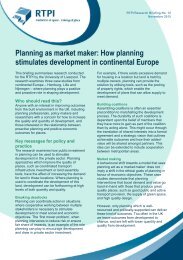estonia-2030_en
estonia-2030_en
estonia-2030_en
You also want an ePaper? Increase the reach of your titles
YUMPU automatically turns print PDFs into web optimized ePapers that Google loves.
spare time sp<strong>en</strong>t and major transport hubs (train and bus stops and others). Networks for light trafficthat are used actively need to be usable year-round.In the context of the linkage of various transport modes, there emerges the important issue of thedevelopm<strong>en</strong>t of secure parking facilities on a suffici<strong>en</strong>t scale at major public transport stops (railwaystations and major bus stops). This would allow bicycle and pass<strong>en</strong>ger-car vehicles to be betteraligned with public transport facilities.4.2.3. Provision of mobility facilities for low-d<strong>en</strong>sity settlem<strong>en</strong>tIn an area with low-d<strong>en</strong>sity settlem<strong>en</strong>t, choosing appropriate transport solutions is very important. Ifpossible, prefer<strong>en</strong>ce should be giv<strong>en</strong> to the combined use of pass<strong>en</strong>ger and public vehicles.Inevitably, private transport (including travel by automobile) will remain the main transport mode forlow-d<strong>en</strong>sity settlem<strong>en</strong>t also in the future, which will impose requirem<strong>en</strong>ts of its own on the quality oflocal road networks, traffic safety and organisation. The EU climate and <strong>en</strong>ergy policies may necessitatechanges for the taxation of transport (polluter/user pays principle). In this ev<strong>en</strong>t, mobility-relatedcosts must remain affordable in rural areas, where public transport is insuffici<strong>en</strong>t and the utilisationof a pass<strong>en</strong>ger vehicle is indisp<strong>en</strong>sable.At the same, time the quality of public transport may also be improved in sparsely populated areas.Dep<strong>en</strong>ding on demand, effici<strong>en</strong>cy can be increased, too: by using the appropriate type of bus (replacinglarge buses with smaller ones on routes with few pass<strong>en</strong>gers) or adjusting the service schedule,applying alternative solutions (altering the route, schedule or vehicle of a bus service) in case of rapidlychanging demand, preferring flexible (pre-bookable public transport) instead of scheduled servicesor other smart solutions.4.2.4. Reciprocal linkage of daily activity spacesIn the reciprocal linkage of daily activity spaces and providing mobility facilities betwe<strong>en</strong> largerc<strong>en</strong>tres in mainland Estonia, railway services have an important role. Its pot<strong>en</strong>tial is illustrated by thefact that as much as 80% of Estonia’s population are living in the vicinity of the existing railway routes(see Figure 8). This suggests that the utilisation of railway services could be increased significantly.Railway services are the only national mobility mode by means of which distances across space andtime may be reduced significantly. On roads, speeds cannot be increased to the same ext<strong>en</strong>t or assafely. Railway services at a technically good level allow travel speeds of 120 to 160 kilometres perhour, time-effici<strong>en</strong>t travel (including to work on a daily basis) or long-distance travel. In addition to34




